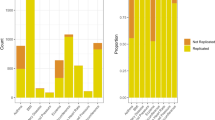Abstract
Genome-wide association studies involving hundreds of thousands of SNPs in thousands of cases and controls are now underway. The first of many analytical challenges in these studies involves the choice of SNPs to genotype. It is not practical to construct a different panel of tag SNPs for each study, so the first generation of genome-wide scans will use predefined, commercially available marker panels, which will in part dictate their success or failure. We compare different approaches in use today, and show that although many of them provide substantial coverage of common variation in non-African populations, the precise extent is strongly dependent on the frequencies of alleles of interest and on specific considerations of study design. Overall, despite substantial differences in genotyping technologies, marker selection strategies and number of markers assayed, the first-generation high-throughput platforms all offer similar levels of genome coverage.
This is a preview of subscription content, access via your institution
Access options
Subscribe to this journal
Receive 12 print issues and online access
$209.00 per year
only $17.42 per issue
Buy this article
- Purchase on Springer Link
- Instant access to full article PDF
Prices may be subject to local taxes which are calculated during checkout




Similar content being viewed by others
References
Altshuler, D. et al. A haplotype map of the human genome. Nature 437, 1299–1320 (2005).
Hinds, D.A. et al. Whole-genome patterns of common DNA variation in three human populations. Science 307, 1072–1079 (2005).
Wang, W.Y., Barratt, B.J., Clayton, D.G. & Todd, J.A. Genome-wide association studies: theoretical and practical concerns. Nat. Rev. Genet. 6, 109–118 (2005).
Hirschhorn, J.N. & Daly, M.J. Genome-wide association studies for common diseases and complex traits. Nat. Rev. Genet. 6, 95–108 (2005).
Palmer, L.J. & Cardon, L.R. Shaking the tree: mapping complex disease genes with linkage disequilibrium. Lancet 366, 1223–1234 (2005).
Botstein, D. & Risch, N. Discovering genotypes underlying human phenotypes: past successes for mendelian disease, future approaches for complex disease. Nat. Genet. 33 (Suppl.), 228–237 (2003).
Neale, B.M. & Sham, P.C. The future of association studies: gene-based analysis and replication. Am. J. Hum. Genet. 75, 353–362 (2004).
Clayton, D.G. et al. Population structure, differential bias and genomic control in a large-scale, case-control association study. Nat. Genet. 37, 1243–1246 (2005).
de Bakker, P.I. et al. Efficiency and power in genetic association studies. Nat. Genet. 37, 1217–1223 (2005).
Dong, S. et al. Flexible use of high-density oligonucleotide arrays for single-nucleotide polymorphism discovery and validation. Genome Res. 11, 1418–1424 (2001).
Carlson, C.S. et al. Selecting a maximally informative set of single-nucleotide polymorphisms for association analyses using linkage disequilibrium. Am. J. Hum. Genet. 74, 106–120 (2004).
Ke, X. et al. A comparison of tagging methods and their tagging space. Hum. Mol. Genet. 14, 2757–2767 (2005).
Pritchard, J.K. & Przeworski, M. Linkage disequilibrium in humans: models and data. Am. J. Hum. Genet. 69, 1–14 (2001).
Jorgenson, E. & Witte, J.S. Coverage and power in genomewide association studies. Am. J. Hum. Genet. 78, 884–888 (2006).
Daly, M. et al. Evaluating and improving power in whole-genome association studies using fixed marker sets. Nat. Genet. advance online publication 21 May 2006 (doi:10.1038/ng1816).
Klein, R.J. et al. Complement factor H polymorphism in age-related macular degeneration. Science 308, 385–389 (2005).
Rieder, M.J. et al. Effect of VKORC1 haplotypes on transcriptional regulation and warfarin dose. N. Engl. J. Med. 352, 2285–2293 (2005).
Hardenbol, P. et al. Highly multiplexed molecular inversion probe genotyping: over 10,000 targeted SNPs genotyped in a single tube assay. Genome Res. 15, 269–275 (2005).
Barrett, J.C., Fry, B., Maller, J. & Daly, M.J. Haploview: analysis and visualization of LD and haplotype maps. Bioinformatics 21, 263–265 (2005).
Acknowledgements
We wish to thank M. Daly, I. Pe'er, L. Palmer, M. Barnes and the WTCCC analysis group, particularly D. Clayton and P. Donnelly, for discussions on many of these topics. We thank D. Evans for comments on the manuscript. We also thank the investigators and participants in the International HapMap project for generating the unique data set and making it available to the scientific community. The authors are supported by the Wellcome Trust, the US National Institutes of Health and a grant from the European Union (MolPAGE).
Author information
Authors and Affiliations
Corresponding author
Ethics declarations
Competing interests
The authors declare no competing financial interests.
Supplementary information
Supplementary Figure 1
Coverage by r2 threshold. (PDF 29 kb)
Supplementary Figure 2
HapMap and ENCODE allele frequencies. (PDF 27 kb)
Rights and permissions
About this article
Cite this article
Barrett, J., Cardon, L. Evaluating coverage of genome-wide association studies. Nat Genet 38, 659–662 (2006). https://doi.org/10.1038/ng1801
Received:
Accepted:
Published:
Issue Date:
DOI: https://doi.org/10.1038/ng1801
This article is cited by
-
Contributions of common genetic variants to risk of schizophrenia among individuals of African and Latino ancestry
Molecular Psychiatry (2020)
-
Global, pathway and gene coverage of three Illumina arrays with respect to inflammatory and immune-related pathways
European Journal of Human Genetics (2019)
-
Response to interferon-beta treatment in multiple sclerosis patients: a genome-wide association study
The Pharmacogenomics Journal (2017)
-
Genome-wide linkage and association study implicates the 10q26 region as a major genetic contributor to primary nonsyndromic vesicoureteric reflux
Scientific Reports (2017)
-
Evaluation of power of the Illumina HumanOmni5M-4v1 BeadChip to detect risk variants for human complex diseases
European Journal of Human Genetics (2016)



